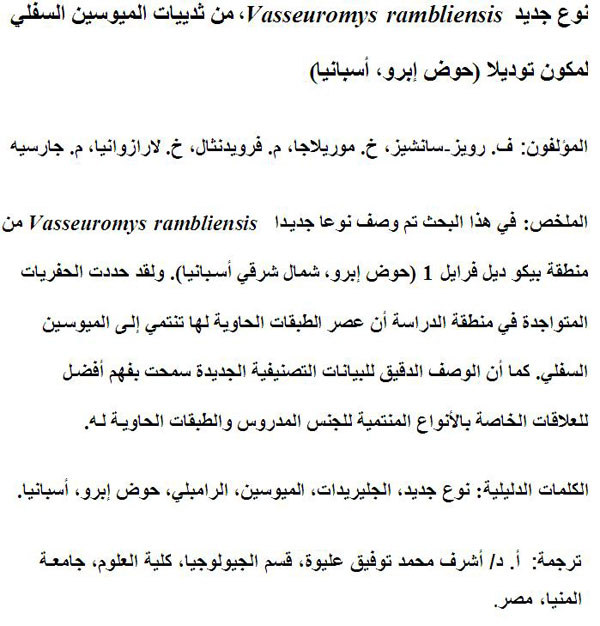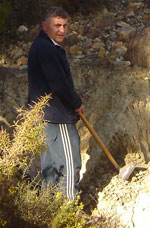Article Search
Vasseuromys rambliensis sp. nov. (Gliridae, Mammalia) from the Ramblian (Lower Miocene) of the Tudela Formation (Ebro basin, Spain)
Plain Language Abstract
A new species of dormouse, Vasseuromys rambliensis sp. nov., is described from the fossiliferous locality Pico del Fraile 1 (Ebro basin, eastern Spain). This new dormouse lived in eastern Spain 17.2 million years ago. It has been found together with other rodent species (Ligerimys sp., Peridyromys murinus (a dormouse) and Simplomys simplicidens (another dormouse), Lagomorpha indet. (a rabbit) and Soricidae indet. (a shrew) that are compatible with the inferred age. The fossil record of the genus Vasseuromys in Europe between 20 and 16.5 million years was only documented by the presence of V. elegans in German localities, but no records of the genus were known in the Iberian Peninsula for this time span. The new species forms part of the Iberian lineage: V. autolensis, V. bacchius and V. rambliensis sp. nov.
Resumen en Español
Vasseuromys rambliensis sp. nov. (Gliridae, Mammalia) del Rambliense (Mioceno inferior) de la Formación Tudela (Cuenca del Ebro, España)
En este trabajo se describe una nueva especie del género Vasseuromys, V. rambliensis sp. nov., de la localidad Pico del Fraile 1 (PF1, Cuenca del Ebro, Noreste de España). La asociación de Ligerimys, Peridyromys murinus y Simplomys simplicidens, y la ausencia de Eucricetodon y Democricetodon, permiten asignar la localidad PF1 al Rambliense superior (Mioceno inferior, MN3, zona local A). Los principales caracteres diagnósticos de V. rambliensis sp. nov. son la presencia en los molares inferiores de cuatro crestas accesorias y un anterotrópido muy reducido, y de un metalofo conectado al posterolofo y no al protocono. El tamaño y la morfología de V. rambliensis sp. nov. son muy parecidos a los de V. bacchius de la parte superior de la unidad MN2, especie esta última a partir de la cual puede haber derivado. Los nuevos datos aportados en este trabajo permiten profundizar en el conocimiento sobre las relaciones filogenéticas entre las especies del género Vasseuromys y su uso en bioestratigrafía.
Palabras claves: nueva especie; Gliridae; Mioceno; Rambliense; Cuenca del Ebro; España
Traducción: los autores
Résumé en Français
Vasseuromys rambliensis sp. nov. (Gliridae, Mammalia) du Ramblien (Miocène inférieur) de la Formation Tudela (Bassin de l’Ebro, Espagne)
Dans ce papier, une nouvelle espèce du genre Vasseuromys est décrite, V. rambliensis sp. nov., provenant de la localité Pico del Fraile 1 (PF1, bassin de l’Ebro, nord-est de l’Espagne). L’association avec Ligerimys, Peridyromys murinus et Simplomys simplicidens, et l’absence de Eucricetodon et Democricetodon, permet de dater la localité PF1 comme Ramblienne supérieure (Miocène inférieur, MN3, zone local A). Les principales caractéristiques diagnostiques de V. rambliensis sp. nov. sont la présence de 4 crêtes supplémentaires sur les molaires inférieures, un antérotropide très réduit et un métalophe connecté aux postérolophe mais pas au protocône. La taille et la morphologie de V. rambliensis sp. nov. sont proches de celle de l’espèce V. bacchius, provenant de la partie haute de l’unité MN2, à partir de laquelle elle pourrait avoir évoluée. Ces nouvelles données permettent une meilleure compréhension des relations au sein du genre et de sa biostratigraphie.
Mots clés: nouvelle espèce; Gliridae; Miocène; Ramblien; Bassin de l’Ebro; Espagne
Translator: Olivier Maridet
Deutsche Zusammenfassung
Vasseuromys rambliensis sp. nov. (Gliridae, Mammalia) aus dem Ramblium (unteres Miozän) der Tudela Formation (Ebro Becken, Spanien)
In dieser Abhandlung wird eine neue Art von Vasseuromys, V. rambliensis sp. nov., aus der Localität Pico del Fraile 1 (PF1, Ebro Becken, Nordost-Spanien) beschrieben. Die Verbindung von Ligerimys, Peridyromys murinus und Simplomys simplicidens und die Abwesenheit von Eucricetodon und Democricetodon erlaubt es die PF1 – Lokalität als spätes Ramblium (frühes Miozän, MN3, Lokalzone A) zu datieren. Die diagnostischen Hauptmerkmale von V. rambliensis sp. nov. sind das Vorhandensein von vier zusätzlichen Graten auf den unteren Molaren, ein sehr reduziertes Anterotropid und die Verbindung des Metalophus mit dem Posterolophus und nicht mit dem Protoconus. V. rambliensis sp. nov. ist in Größe und Morphologie V. bacchius aus der Einheit MN2 sehr ähnlich. Möglicherweise stammt es von diesem ab. Die neuen Daten erhellen die Verwandtschaftsverhältnisse innerhalb der Gattung sowie deren Biostratigraphie.
SCHLÜSSELWÖRTER: neue Art; Gliridae; Miozän; Ramblium; Ebro Becken; Spanien
Translator: Eva Gebauer
Arabic

Translator: Ashraf M.T. Elewa
Polski Abstrakt
GATUNEK VASSEUROMYS RAMBLIENSIS SP. NOV. (GLIRIDAE, MAMMALIA) Z RAMBLIANU (NIŻSZY MIOCEN) FORMACJI TUDELA (BASEN EBRO, HISZPANIA)
W artykule opisujemy nowy gatunek rodzaju Vasseuromys, V. rambliensis sp. nov. ze stanowiska Pico del Fraile 1 (PF1, basen Ebro, pólnocno-wschodnia Hiszpania). Obecność w stanowisku PF1 rodzaju Ligerimys i gatunków Peridyromys murinus i Simplomys simplicidens pozwala datować je na późny ramblian (wczesny miocen, MN3, lokalna strefa A). Głównymi cechami diagnostycznymi gatunku V. rambliensis sp. nov. jest obecność czterech dodatkowych prążków na dolnych trzonowcach, bardzo zredukowany anterotropid oraz metalof połączony z posterolofem, a nie z protokonem. Rozmiar i morfologia gatunku V. rambliensis sp. nov. są bardzo zbliżone do gatunku V. bacchius z górnej partii jednostki MN2, z której on najprawdopodobniej pochodzi. Nowe dane pozwalają na lepsze zrozumienie pokrewieństw w obrębie tego rodzaju i jego biostratygrafii.
Słowa kluczowe: nowy gatunek, Gliridae, miocen, ramblian, basen Ebro, Hiszpania
Translation: Dawid Mazurek and Robert Bronowicz
Riassunto in Italiano
Vasseuromys rambliensis sp. nov. (Gliridae, Mammalia) del Rambliano (Miocene inferiore) della Tudela Fm (bacino dell’Ebro, Spagna)
Descriviamo una nuova specie di Vasseuromys, V. rambliensis sp. nov., dalla località Pico del Fraile 1 (PF1, bacino dell’Ebro, Spagna nord-orientale). La compresenza di Ligerimys, Peridyromys murinus e Simplomys simplicidens, e l’assenza di Eucricetodon e Democricetodon permettono di datare la località PF1 al Rambliano superiore (Miocene inferiore, MN3, local zone A). Le caratteristiche diagnostiche di V. rambliensis sp. nov. sono la presenza di quattro creste addizionali nei molari inferiori, un anterotropide molto ridotto e un metalofo connesso al posterolofo e non al protocono. La taglia e la morfologia di V. rambliensis sp. nov. sono molto vicine a V. bacchius della parte superiore dell’ MN2, ed è possibile che l’uno derivi dall’altro. I nuovi dati qui presentati permetono una migliore comprensione delle relazioni all’interno di questo genere e della sua biostratigrafia.
Parole chiave: nuova specie; Gliridae; Miocene; Rambliano; bacino dell’Ebro; Spagna
Translator: Chiara Angelone
Francisco J. Ruiz-Sánchez Area de Paleontologia
Area de Paleontologia
Universitat de València
Dr. Moliner s/n
46100 Burjassot
Spain
Francisco J. Ruiz (Paco) is a palaeontologist with special interest in the study of fossil rodents (Cricetidae, Gliridae, Eomyidae) from Miocene deposits. His main work areas are the Tertiary Spanish continental basins (Magro, Ebro, Ribesalbes-Alcora, Alcoy, etc.). Francisco J. is Associate Professor in the Department of Geology in the University of Valencia, Spain.
 Xabier Murelaga
Xabier Murelaga
Departamento de Estratigrafía y Paleontología
Universidad del País Vasco
Bilbao
Aptdo. 644, E-48080
Spain
Xabier Murelaga is a palaeontologist whose research covers a variety of subjects like taxonomy of Tertiary and Quaternary fossil microvertebrates and taxonomy and evolution of Mesozoic and Cenozoic turtles. Xabier is Assistant Lecturer in the Department of Stratigraphy and Palaeontology in the University of Basque Country.
Matthijs Freudenthal Departamento de Estratigrafíay Paleontología
Departamento de Estratigrafíay Paleontología
Universidad de Granada
Granada 18071
Spain
and Nationaal Natuurhistorisch Museum
Leiden
The Netherlands
Matthijs Freudenthal is a former curator of vertebrate paleontology of the National Museum of Natural History, Naturalis, Leiden, the Netherlands. He is actually working at the University of Granada, Spain. He is one of the pioneers of fossil micromammal research in Europe. His most recent research covers a variety of subjects like taxonomy of Gliridae, correspondance analysis in vertebrate palaeontology, the insular faunas from Gargano (Italy) and body mass estimates in fossil rodents.
 Juan C. Larrasoaña
Juan C. Larrasoaña
Instituto Geológico y Minero de España
Unidad de Zaragoza 50006
Spain
Juan C. Larrasoaña is a geologist specialized in the application of palaeomagnetic techniques to a wide range of studies in Earth Sciences. One of his research interests is the magnetostratigraphic dating of fossil-bearing marine and continental successions, which provides the basis for interpreting the palaeontological record in terms of evolutionary changes. Since 2009, Juan C. Larrasoaña is a staff scientist in the Zaragoza headquarters of the Spanish Geological Survey (IGME).
Miguel Garcés Grup de Geodinàmica i Anàlisi de Conques
Grup de Geodinàmica i Anàlisi de Conques
Universitat de Barcelona
Zona Universitaria de Pedralbes
Barcelona 08028
Spain
Miguel Garcés is an Associate Professor in the University of Barcelona, head of the Palaeomagnetic Laboratory of the University of Barcelona-CSIC and president of the Palaeomagnetism Subcomission of the Spanish Geological Society. His research interests are: I) Palaeomagnetism applied to Basin Analysis Studies, II) Calibration of the Geological Time Scale, magnetostratigraphic dating of marine and continental bioevents, cyclostratigraphy and Astronomical tuning, and III) Evolution of continental Palaeoenvironments, age calibration of intercontinental dispersal events of mammalian faunas and correlation with global events.
TABLE 1. Measurements in millimetres of the lower and upper teeth of V. rambliensis sp. nov. from PF1.
|
Element |
Parameter |
n |
min. |
mean |
Max. |
|
d4 |
L |
2 |
0.91 |
0.94 |
0.96 |
|
|
W |
2 |
0.83 |
0.88 |
0.93 |
|
|
|
|
|
|
|
|
p4 |
L |
1 |
|
1.10 |
|
|
|
W |
1 |
|
1.09 |
|
|
|
|
|
|
|
|
|
m1 |
L |
2 |
1.24 |
1.30 |
1.36 |
|
|
W |
1 |
|
1.33 |
|
|
|
|
|
|
|
|
|
m2 |
L |
5 |
1.40 |
1.46 |
1.51 |
|
|
W |
5 |
1.34 |
1.42 |
1.49 |
|
|
|
|
|
|
|
|
m3 |
L |
5 |
1.27 |
1.35 |
1.44 |
|
|
W |
5 |
1.22 |
1.28 |
1.36 |
|
|
|
|
|
|
|
|
D4 |
L |
4 |
0.81 |
0.87 |
0.94 |
|
|
W |
4 |
0.94 |
0.99 |
1.05 |
|
|
|
|
|
|
|
|
P4 |
L |
3 |
1.04 |
1.07 |
1.10 |
|
|
W |
2 |
1.34 |
1.35 |
1.36 |
|
|
|
|
|
|
|
|
M1 |
L |
1 |
|
1.40 |
|
|
|
W |
1 |
|
1.67 |
|
|
|
|
|
|
|
|
|
M2 |
L |
4 |
1.29 |
1.40 |
1.49 |
|
|
W |
4 |
1.69 |
1.78 |
1.83 |
|
|
|
|
|
|
|
|
M3 |
L |
1 |
|
1.25 |
|
|
|
W |
1 |
|
1.40 |
|
|
|
|
|
|
|
|
TABLE 2. Measurement values of concavity in V. rambliensis sp. nov. of PF1 (12 specimens; 2 m1 inf. ant., 1 m1 inf. post., 4 m2 inf. ant., 4 m2 inf. post., 1 m1 sup. ant., 1 m1 sup. post., 4 m2 sup. ant. and 5 m2 sup. post. profiles) and comparison with V. autolensis from Autol 1 (1 specimen) and V. duplex from Harami 1 (1 specimen). For more detail see Freudenthal and Martín-Suárez (2007b). Abbreviations: S, surface of concavity profile; w, maximum width of the molar as seen in the profile; b, distance between x and y; h, maximum depth of the concavity; r, radius of the best-fitting circle.
m1 inf. ant. Surf w b h S/b h/b r h/r b/2r w/2r skewness mean dev V. rambliensis mean 0.60 10.00 5.55 0.24 0.11 0.04 3.94 0.09 0.68 1.27 71.65 4.15 V. cristinae mean 1.24 10.00 6.95 0.38 0.18 0.06 5.30 0.07 0.66 0.95 50.90 0.34 V. duplex 1.98 10.00 7.01 0.52 0.28 0.07 10.61 0.05 0.33 0.47 61.4 0.05 m1 inf. post. Surf w b h S/b h/b r h/r b/2r w/2r skewness mean dev V. rambliensis 1.42 9.96 6.56 0.39 0.22 0.06 4.97 0.08 0.66 1.00 44.6 0.20 V. cristinae mean 2.46 10.00 6.41 0.77 0.38 0.12 4.13 0.18 0.78 1.22 49.73 0.14 V. duplex 2.96 10.00 7.53 0.71 0.39 0.09 8.84 0.08 0.43 0.57 54.3 0.06 m2 inf. ant. Surf w b h S/b h/b r h/r b/2r w/2r skewness mean dev V. rambliensis mean 1.94 10.00 6.52 0.61 0.30 0.10 4.39 0.14 0.75 1.15 54.98 0.19 V. cristinae mean 2.27 10.00 6.62 0.66 0.34 0.10 4.80 0.14 0.69 1.05 67.28 0.19 V. autolensis 2.92 10.00 7.09 0.77 0.41 0.11 7.44 0.10 0.48 0.67 65.8 0.09 m2 inf. post. Surf w b h S/b h/b r h/r b/2r w/2r skewness mean dev V. rambliensis mean 1.49 10.00 6.23 0.40 0.23 0.06 4.51 0.09 0.69 1.12 70.33 0.23 V. cristinae mean 2.33 10.00 6.39 0.65 0.36 0.10 4.34 0.15 0.74 1.17 69.73 0.20 V. autolensis 4.42 10.00 7.25 1.07 0.61 0.15 5.70 0.19 0.64 0.88 57.0 0.10 m1 sup. ant. Surf w b h S/b h/b r h/r b/2r w/2r skewness mean dev V. rambliensis 3.12 10.00 7.75 0.71 0.40 0.09 5.24 0.14 0.74 0.95 58.3 0.19 V. cristinae mean 2.85 10.00 6.06 0.85 0.47 0.14 3.91 0.22 0.78 1.29 52.17 0.10 V. autolensis 4.44 10.00 7.42 1.04 0.60 0.14 7.09 0.15 0.52 0.71 61.7 0.07 V. duplex 4.30 10.00 7.60 0.95 0.57 0.13 7.80 0.12 0.49 0.64 47.7 0.04 m1 sup. post. Surf w b h S/b h/b r h/r b/2r w/2r skewness mean dev V. rambliensis 3.77 10.00 8.21 0.78 0.46 0.10 5.66 0.14 0.72 0.88 65.3 0.24 V. cristinae mean 3.64 10.00 7.14 0.91 0.51 0.13 4.57 0.20 0.79 1.10 55.43 0.16 V. autolensis 4.18 10.00 7.48 1.07 0.56 0.14 6.05 0.18 0.62 0.83 53.7 0.09 V. duplex 3.75 10.00 7.55 0.91 0.50 0.12 7.93 0.11 0.48 0.63 53.7 0.07 m2 sup. ant. Surf w b h S/b h/b r h/r b/2r w/2r skewness mean dev V. rambliensis mean 2.32 10.00 6.50 0.63 0.35 0.10 4.28 0.15 0.77 1.20 55.23 0.17 V. cristinae mean 4.37 10.00 6.80 1.14 0.65 0.17 3.84 0.30 0.89 1.30 62.55 0.12 V. autolensis 4.97 10.00 6.54 1.21 0.76 0.19 4.71 0.26 0.69 1.06 48.6 0.04 V. duplex 5.86 10.00 7.61 1.31 0.77 0.17 5.74 0.23 0.66 0.87 56.6 0.07 m2 sup. post. Surf w b h S/b h/b r h/r b/2r w/2r skewness mean dev V. rambliensis mean 2.95 10.01 7.31 0.68 0.40 0.09 4.98 0.14 0.73 1.01 54.02 3.16 V. cristinae mean 3.39 10.00 7.61 0.83 0.45 0.11 5.32 0.16 0.72 0.95 59.90 0.18 V. autolensis 4.01 10.00 7.84 0.95 0.51 0.12 8.08 0.12 0.49 0.62 56.7 0.11 V. duplex 4.77 10.00 8.13 1.05 0.59 0.13 7.76 0.14 0.52 0.64 56.9 0.08
TABLE 3. Comparison of h/r concavity values. The limits between weakly and moderately concave are taken from Freudenthal and Martín-Suárez (2007b).
h/r m1 m2 M1 M2 species ant post ant post ant post ant post V. rambliensis 0.09 0.08 0.14 0.09 0.14 0.14 0.15 0.14 V. cristinae 0.07 0.18 0.14 0.15 0.22 0.20 0.30 0.16 V. autolensis 0.10 0.19 0.15 0.18 0.26 0.12 V. duplex 0.05 0.08 0.12 0.11 0.23 0.14 limit weak/moderate 0.18 0.13 0.17 0.13 0.15 0.12 0.14 0.11
FIGURE 1. Geological map of the continental sediments of the Tudela Formation in the Bardenas Reales de Navarra area, with location of the Pico del Fraile section and the Pico del Fraile 1 (PF1) locality. The location of other fossil localities studied previously by Murelaga (2000) and Murelaga et al. (2004a and 2004b) is also shown.

FIGURE 2. Composite lithostratigraphic and magnetostratigraphic logs of the Tudela Formation (see Larrasoaña et al., 2006) and their correlation to the ATNTS2004 of Lourens et al. (2004). The position of locality PF1 is described in this study; for the other fossil localities see Murelaga (2000) and Murelaga et al. (2004a, 2004b).

FIGURE 3. Nomenclature of parts of the cheek teeth, adapted after Freudenthal (2004).

FIGURE 4. Vasseuromys rambliensis sp. nov. from PF1, Ebro basin, Spain. 1, PF1 29, left d4; 2, PF1 30, left d4; 3, PF1 28, left p4; 4, PF1 15 (holotype), right m1; 5, PF1 8, right m2; 6, PF1 12, left m2; 7, PF1 16, right m2; 8, PF1 9, right m3; 9, PF1 10, right m3; 10, PF1 11, right m3; 11, PF1 24, left D4; 12, PF1 27, right D4; 13, PF1 37, right P4; 14, PF1 2, left M1; 15, PF1 1, right M2; 16, PF1 3, left M2; 17, PF1 58, left M2; 18, PF1 36, left M3. Scale bar equals 1 mm.

FIGURE 5. Ranges of variation of length and width (tenths of millimeters) of the lower molars of V. rambliensis sp. nov. from PF1, V. pannonicus from Eichkogel, V. elegans from Stubersheim 3, V. duplex from Harami 1, V. bacchius from Fuenmayor 2, V. rugosus from Santa Cilia and Laugnac, V. priscus from Santa Cilia and V. autolensis from Autol 1.

FIGURE 6. Ranges of variation of length and width (tenths of millimeters) of the upper molars of V. rambliensis sp. nov. from PF1, V. pannonicus from Eichkogel, V. elegans from Stubersheim 3, V. duplex from Harami 1, V. bacchius from Fuenmayor 2, V. rugosus from Santa Cilia and Laugnac, V. priscus from Santa Cilia and Moissac 1 and V. autolensis from Autol 1.

FIGURE 7. Ranges of concavity of anterior and posterior side of m1, m2, M1 and M2 of Vasseuromys duplex from Harami 1, V. autolensis from Autol 1, V. rambliensis sp. nov. from PF1 and V. cristinae from PF2. The dashed lines indicate the limits between weakly and moderately concave (from Freudenthal and Martín-Suárez, 2007b).


